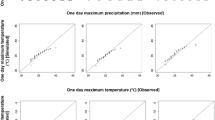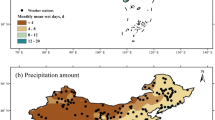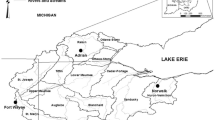Abstract
Previous studies have investigated the character and distribution of intense precipitation events across the United States. Increasing trends in intense, daily precipitation events at heavy (90–< 95th percentile), very heavy (95–< 99th percentile), and extreme (≥ 99th percentile) thresholds have all been reported. However, no previous studies have investigated the potential application of stochastic weather generators in determining future, site-specific distributions of such intense precipitation occurrences. In this study, two scenarios of future changes in intense precipitation for Weatherford, Oklahoma were examined through the use of a specific weather generator, SYNTOR, and by examination of heavy, very heavy, and extreme precipitation categories. All precipitation events across the three categories were increased multiple times by eight different percentages ranging from 5% to 75%, while precipitation events within the three categories were simultaneously increased by 14%, 20%, and 30%, respectively. Projected changes in the occurrence and categorical thresholds of intense precipitation events, as well as total monthly and annual precipitation and wet-dry transition probabilities, were assessed. The findings of this study show that projected increases in intense precipitation ranging from 5% to 40% are plausible and within the margin of error, based on the application of the two intensification scenarios to the synthetically generated weather data. Overall, the precipitation intensification scenarios markedly impacted estimates of intense precipitation, as well as average annual and monthly precipitation totals, but did not markedly impact the temporal distribution of precipitation annually or across seasons, nor the transition probabilities of projected precipitation between wet and dry days. Precipitation intensification scenarios can ultimately benefit in simulating erosion, runoff, and crop productivity responses to future precipitation distributions in agricultural watersheds of the Southern Great Plains as well as other locations.







Similar content being viewed by others
References
Ailliot P, Allard D, Monbet V, Naveau P (2015) Stochastic weather generators: an overview of weather type models. Journal de la Société Française de Statistique 156(1):101–113
Alexander LV, Zhang X, Peterson TC, Caesar J, Gleason B, Tank AK, ... Tagipour A (2006). Global observed changes in daily climate extremes of temperature and precipitation. Journal of Geophysical Research: Atmospheres, 111(D5)
Asseng S, Ewert F, Rosenzweig C, Jones JW, Hatfield JL, Ruane AC et al (2013) Uncertainty in simulating wheat yields under climate change. Nat Clim Chang 3(9):827–832
Bazzi M, Blasques F, Koopman SJ, Lucas A (2017) Time-varying transition probabilities for Markov regime switching models. J Time Ser Anal 38(3):458–478
Bonaccorso B, Cancelliere A, Rossi G (2015) Probabilistic forecasting of drought class transitions in Sicily (Italy) using standardized precipitation index and North Atlantic oscillation index. J Hydrol 526:136–150
Brock FV, Crawford KC, Elliott RL, Cuperus GW, Stadler SJ, Johnson HL, Eilts MD (1995) The Oklahoma Mesonet: a technical overview. J Atmos Ocean Technol 12(1):5–19
Butler EE, Huybers P (2013) Adaptation of US maize to temperature variations. Nat Clim Chang 3(1):68–72
Delpla I, Jung AV, Baures E, Clement M, Thomas O (2009) Impacts of climate change on surface water quality in relation to drinking water production. Environ Int 35(8):1225–1233
Easterling DR, Evans JL, Groisman PY, Karl TR, Kunkel KE, Ambenje P (2000) Observed variability and trends in extreme climate events: a brief review. Bull Am Meteorol Soc 81(3):417–426
Elliott RL, Schiebe FR, Crawford KC, Peter KD, Puckett WE (1993). A unique data capability for natural resources studies. International Winter Meeting of the American Society of Agricultural Engineering, Paper No. 932529, American Society of Agricultural Engineers, 2950 Niles Road, St. Joseph, MI, 14 pp
Elliott RL, Brock FV, Stone ML, Harp SL (1994) Configuration decisions for an automated weather station network. Appl Eng Agric 10(1):45–51
Feng G, Cobb S, Abdo Z, Fisher DK, Ouyang Y, Adeli A, Jenkins JN (2016) Trend analysis and forecast of precipitation, reference evapotranspiration, and rainfall deficit in the Blackland Prairie of Eastern Mississippi. J Appl Meteorol Climatol 55(7):1425–1439
Fiebrich CA, Crawford KC (2009) Automation: a step toward improving the quality of daily temperature data produced by climate observing networks. J Atmos Ocean Technol 26(7):1246–1260
Garbrecht J (2012) Random, but uniform please: requirements for synthetic precipitation generation for computer simulations in agriculture. Appl Eng Agric 28(2):207–217
Garbrecht JD, Busteed P (2011). SYNTOR: A Synthetic Daily Weather Generator Version 3.5 User Manual. Grazinglands Research Laboratory, GRL 1-11. USDA-ARS, El Reno, Oklahoma
Garbrecht JD, Zhang JX (2011). Synthetic Weather Generator SYNTOR: implementing improvements in precipitation generation. In World Environmental and Water Resources Congress 2011: Bearing Knowledge for Sustainability (pp. 4698-4701)
Garbrecht JD, Zhang JX (2012) Generating synthetic daily precipitation realizations for seasonal precipitation forecasts. J Hydrol Eng 19(1):252–264
Garbrecht JD, Zhang XC, Steiner JL (2014) Climate change and observed climate trends in the Fort Cobb experimental watershed. J Environ Qual 43(4):1319–1327
Garbrecht JD, Nearing MA, Zhang JX, Steiner JL (2016) Uncertainty of climate change impacts on soil erosion from cropland in central Oklahoma. Appl Eng Agric 32(6):823–836
Garbrecht JD, Zhang XC, Brown D, Busteed P (2019) Generation of synthetic daily weather for climate change scenarios and extreme storm intensification. Environment and Natural Resources Research 9(2):1–14
Groisman PY, Karl TR, Easterling DR, Knight RW, Jamason PF, Hennessy KJ, ... & Razuvaev VN (1999). Changes in the probability of heavy precipitation: important indicators of climatic change. In Weather and Climate Extremes (pp. 243-283). Springer, Dordrecht
Groisman PY, Knight RW, Karl TR (2001) Heavy precipitation and high streamflow in the contiguous United States: trends in the twentieth century. Bull Am Meteorol Soc 82(2):219–246
Groisman PY, Knight RW, Karl TR, Easterling DR, Sun B, Lawrimore JH (2004) Contemporary changes of the hydrological cycle over the contiguous United States: trends derived from in situ observations. J Hydrometeorol 5(1):64–85
Groisman PY, Knight RW, Easterling DR, Karl TR, Hegerl GC, Razuvaev VN (2005) Trends in intense precipitation in the climate record. J Clim 18(9):1326–1350
Groisman PY, Knight RW, Karl TR (2012) Changes in intense precipitation over the central United States. J Hydrometeorol 13(1):47–66
Joshi S, Xu Y (2015) Assessment of suspended sand availability under different flow conditions of the Lowermost Mississippi River at Tarbert Landing during 1973–2013. Water 7(12):7022–7044
Joshi S, Xu YJ (2017) Bedload and suspended load transport in the 140-km reach downstream of the Mississippi River avulsion to the Atchafalaya River. Water 9(9):716
Joshi S, Garbrecht JD, Brown D (2019) Observed spatiotemporal trends in intense precipitation events across United States: applications for stochastic weather generation. Climate 7(3):36
Karl TR, Knight RW (1998) Secular trends of precipitation amount, frequency, and intensity in the United States. Bull Am Meteorol Soc 79(2):231–242
Karl TR, Knight RW, Easterling DR, Quayle RG (1996) Indices of climate change for the United States. Bull Am Meteorol Soc 77(2):279–292
Karl TR, Melillo JM, Peterson TC, & Hassol SJ. (Eds.). (2009). Global climate change impacts in the United States. Cambridge University Press. 196 pp
Kloesel K, Bartush B, Banner J, Brown DP, Lemery J, Lin L, Loeffler C et al (2018) Southern great plains. USDA Miscellaneous Publication 1343(2):978–1026
Kunkel KE, Easterling DR, Redmond K, Hubbard K (2003) Temporal variations of extreme precipitation events in the United States: 1895–2000. Geophys Res Lett 30(17)
Laflen JM, Elliot WJ, Flanagan DC, Meyer CR, Nearing MA (1997) WEPP-predicting water erosion using a process-based model. J Soil Water Conserv 52(2):96–102
Liang X, Lettenmaier DP, Wood EF, Burges SJ (1994) A simple hydrologically based model of land surface water and energy fluxes for general circulation models. J Geophys Res-Atmos 99(D7):14,415–14,428
Liang XZ, Wu Y, Chambers RG, Schmoldt DL, Gao W, Liu C, Liu YA, Sun C, Kennedy JA (2017) Determining climate effects on US total agricultural productivity. Proc Natl Acad Sci 114(12):E2285–E2292
Lobell DB, Schlenker W, Costa-Roberts J (2011) Climate trends and global crop production since 1980. Science 333(6042):616–620
Masupha TE, Moeletsi ME, Tsubo M (2016) Dry spells assessment with reference to the maize crop in the Luvuvhu River catchment of South Africa. Physics and Chemistry of the Earth, Parts A/B/C 92:99–111
Nearing MA, Deer-Ascough L, Laflen JM (1990) Sensitivity analysis of the WEPP hillslope profile erosion model. Transactions of the ASAE 33(3):839–0849
Nearing MA, Jetten V, Baffaut C, Cerdan O, Couturier A, Hernandez M et al (2005) Modeling response of soil erosion and runoff to changes in precipitation and cover. Catena 61(2-3):131–154
Pielke RA Jr, Downton MW (2000) Precipitation and damaging floods: trends in the United States, 1932–97. J Clim 13(20):3625–3637
Pruski FF, Nearing MA (2002) Runoff and soil-loss responses to changes in precipitation: a computer simulation study. J Soil Water Conserv 57(1):7–16
Rosenzweig C, Tubiello FN, Goldberg R, Mills E, Bloomfield J (2002) Increased crop damage in the US from excess precipitation under climate change. Glob Environ Chang 12(3):197–202
Sonnadara DUJ, Jayewardene DR (2015) A Markov chain probability model to describe wet and dry patterns of weather at Colombo. Theor Appl Climatol 119(1-2):333–340
Troy TJ, Kipgen C, Pal I (2015) The impact of climate extremes and irrigation on US crop yields. Environ Res Lett 10(5):054013
Urban D, Roberts MJ, Schlenker W, Lobell DB (2012) Projected temperature changes indicate significant increase in interannual variability of US maize yields. Clim Chang 112(2):525–533
Whitehead PG, Wilby RL, Battarbee RW, Kernan M, Wade AJ (2009) A review of the potential impacts of climate change on surface water quality. Hydrol Sci J 54(1):101–123
Wilks DS (1998) Multisite generalization of a daily stochastic precipitation generation model. J Hydrol 210(1-4):178–191
Wilks DS, Wilby RL (1999) The weather generation game: a review of stochastic weather models. Prog Phys Geogr 23(3):329–357
Zhang XC (2003) Assessing seasonal climatic impact on water resources and crop production using CLIGEN and WEPP models. Transactions of the ASAE 46(3):685
Zhang XC, Liu WZ (2005) Simulating potential response of hydrology, soil erosion, and crop productivity to climate change in Changwu tableland region on the Loess Plateau of China. Agric For Meteorol 131(3-4):127–142
Zhang XC, Nearing MA (2005) Impact of climate change on soil erosion, runoff, and wheat productivity in central Oklahoma. Catena 61(2-3):185–195
Zhou J, Fu B, Gao G, Lü Y, Liu Y, Lü N, Wang S (2016) Effects of precipitation and restoration vegetation on soil erosion in a semi-arid environment in the Loess Plateau, China. Catena 137:1–11
Acknowledgements
The authors thank Dr. Jurgen Garbrecht for his useful insights during the course of designing the study. The authors also thank National Oceanic and Atmospheric Administration (NOAA) National Centers for Environmental Information (NCEI) for making Weatherford precipitation data available for the study. Finally, the authors thank the anonymous reviewers for their critical reviews on an earlier version of the manuscript.
Author information
Authors and Affiliations
Contributions
S.J., D.B., and P.B. conceived and designed the study; S.J. completed data analysis and wrote the first draft of the manuscript; all authors revised and proofread the manuscript leading to its final submission to the journal.
Corresponding author
Ethics declarations
Conflict of interests
The authors declare no competing interests.
Additional information
Publisher’s note
Springer Nature remains neutral with regard to jurisdictional claims in published maps and institutional affiliations.
Rights and permissions
About this article
Cite this article
Joshi, S., Brown, D. & Busteed, P. Intensification scenarios in projected precipitation using stochastic weather generators: a case study of central Oklahoma. Theor Appl Climatol 144, 1285–1296 (2021). https://doi.org/10.1007/s00704-021-03599-9
Received:
Accepted:
Published:
Issue Date:
DOI: https://doi.org/10.1007/s00704-021-03599-9




